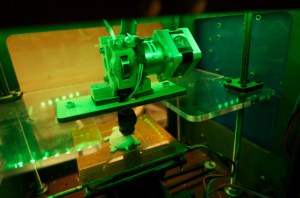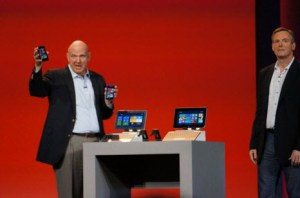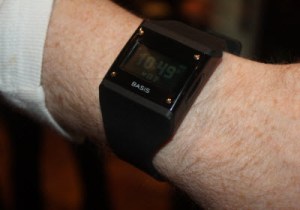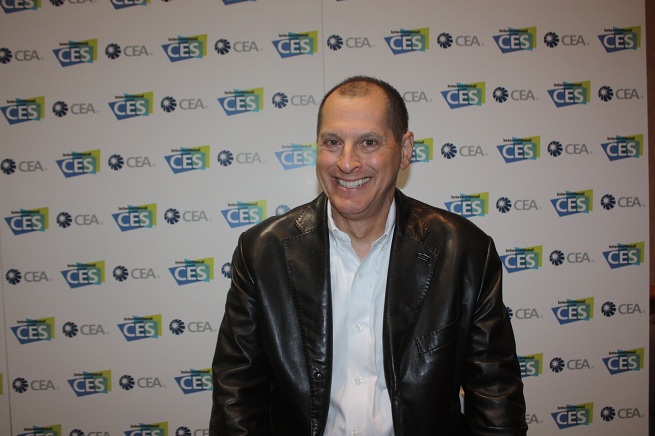There’s a tech boom underway, and that’s good for the industry’s biggest trade show, the 2014 International Consumer Electronics Show, coming Jan. 7 to Jan. 10 in Las Vegas. Gary Shapiro, the president and chief executive of the Consumer Electronics Association, promises that it will be the place to go for innovation.
CES is targeting about 150,000 attendees, 3,300 exhibitors, and about 1.9 million square feet of space. That’s about the same as last year, though exhibitor space has grown. A lot of people will debate whether it’s too crowded to go, or if there will be enough innovation or just a bunch of copycats. But there will be plenty of people there to fill the aisles and lots of new technologies like wearable computers, 3D printing, the Internet of things sensors, fitness watches, car gear, “MommyTech,” tiny mobile gadgets, virtual reality headsets, SteamOS gaming machines, and, of course, giant stereo speakers.
Our preview interview with Shapiro has become an annual ritual. He gets to see the stuff early and sort out the big trends. He also cares a lot about tech policy issues and the overall state of the consumer electronics economy. Here’s an edited transcript of our interview with Shapiro.
Gary Shapiro: We do position the show as the world’s gathering place for everyone who thrives in the business of consumer technologies. It’s all focused on innovation. It’s where innovation goes to market. It’s the promise and the power of technology. It’s everything in the ecosystem. It’s magical. That’s what we do.
I wish I had a different way of saying this, but it’s going to be the best we ever had. [laughs] We have a lot of different trends coming out in a big way. It’s 3,300 different stories from 3,300 different exhibitors.
Running the show itself, we’ve done everything differently that we can. We have new TechZones. We have something called AcademiaTech, focusing on work developed at universities. We have a zone for fashion tech, wearables. That’s become very hot, very quickly. We have the WristRevolution, a new tech zone devoted to wristwatch innovations. There’s a waiting list to get in that one.
The way it works with us, we’re focusing on the 2015 show now. We map it out and say, “We want to reserve these areas for this and that TechZone.” When we go to the show, exhibitors get priority depending on how long they’ve been with us, and they choose their exhibit space. We try to block out TechZones, guessing what might be hot a year ahead of time. Then things come up that we’ve never thought of. It’s a challenge. That’s why some TechZones sell out, because we’ve only allocated so much space.
We have a whole new focus on MEMS, Micro Electro-Mechanical Systems. That’s everything from accelerometers to anything that senses anything. That’s at the core of a lot of new technologies coming down the line. It’s what makes smartphones work. We have a lot in that area. Nine out of the ten largest car companies exhibiting. We have a driverless car TechZone. We have a Go Electric Drive TechZone for electric cars.
One of the hottest areas, as far as selling out, is 3D printing. That’s going to be a major product category. We’re going to see that big-time at CES. It’s on my personal to-buy list for my home. I was watching one that we had here and decided it would help out enormously.
We’re doing a lot with the motion picture industry around Ultra HD and other next-generation stuff. We partner everywhere.

Above: A 3D printer making a turtle.
VB: Is there a lot of a “maker” element to 3D printing, the hobbyist hardware enthusiasts?
Shapiro: Yeah. The CEO of MakerBot is one of the featured speakers at the Leaders in Technology conference. Eureka Park is larger than ever, the startup companies. We’ve created something called Eureka Park Next, with graduates of the program showing where they’re going next. Eureka Park is more than 200 companies now, and this is only the third show we’re doing it.
VB: How did you choose the keynotes this year? What are some of the circumstances that led to the selection of folks you have?
Shapiro: We choose them the way we do every year. We have a brainstorming session and look at our criteria. Those criteria are pretty specific. You must be international. You must be able to say something that’s not just about your company. We want somebody who has something to say. We go for diversity in different senses of the word – diversity of product categories, diversity of geographic regions, diversity in the usual personal sense. Then we list everyone and score them and go after the ones we want.

Above: Steve Ballmer came to Qualcomm’s keynote last year.
VB: I see some people who are in the news, like Brian Krzanich from Intel, will be giving a keynote.
Shapiro: Yeah, this is his first presentation, at least from our view. Marissa Mayer, that’s very exciting to us. Sony giving us everything going on in the many different Sony worlds. The success of their game platform gives them good momentum, but they’re doing so many things. They’re a leader in Ultra HD. They’re engaged in so many areas of the motion picture industry. They’ve never disappointed us.
VB: My own joke would be, Microsoft gave up its standing keynote speech just in time for it to have a very interesting product in the Xbox One.
Shapiro: The big surprise this past year was Steve Ballmer coming to the keynote. Whether that will happen again, I have no idea. But Microsoft certainly has a whole bunch of space at CES, although it’s invitation-only space. It’s a pretty huge investment. We would love to have Microsoft back in the future, although I guess it won’t be Steve, absent some strange surprise.

Above: Basis Science’s fitness watch.
The big change for us is that we now have two keynotes before the show officially opens, the night before, with Brian and with Rupert Stadler from Audi. Then it kicks off Tuesday morning with me and Sony. We’ve just announced John Chambers from Cisco. Cisco’s also a part of one of our new areas of the show, the Internet of Things. Everything being connected is a big deal. A lot of exhibitors are focusing on machine-to-machine or thing-to-thing or whatever you want to call it.
Then we have the returning TechZones – the Digital Health Zone, FitnessTech, the Gaming Showcase. The iLounge is still huge. We have Kids at Play, MommyTech, PMA@CES. Robotics is obviously growing. The Silver Summit. Transforming Education. We have more than 25 TechZones. Plus, we still have some announcements – CEOs of major companies appearing, speaking, and doing different things – in all sorts of hot sectors.
VB: I don’t know if attendance is a concern this year. There seems to be a boom going on. I’d think that would be good for the show.
Shapiro: Definitely in terms of quality attendance. The actual number of bodies is always a concern in that we don’t want to have too many people. We’re a little sensitive about keeping it around 150,000. That’s our goal. We don’t want to tax Las Vegas too much with traffic jams and things like that. Our scrutiny level is a little higher this year, I think. It seems to be building in that direction. We don’t want to overtax the system.

